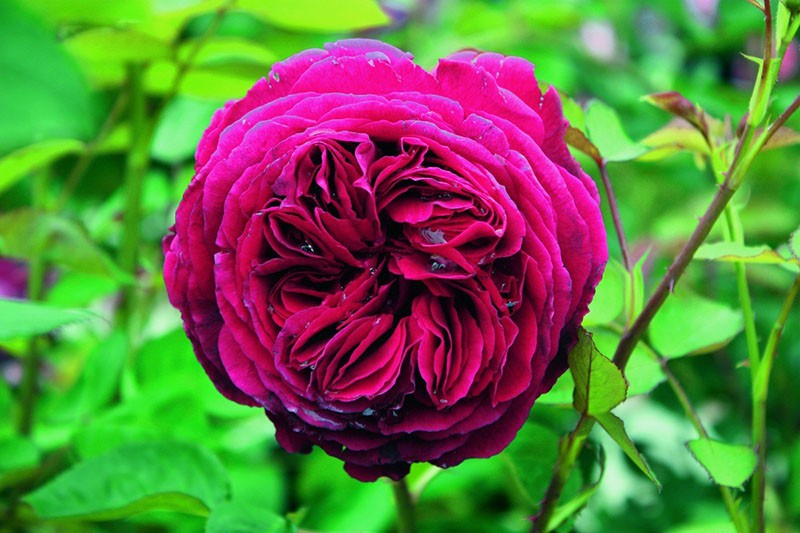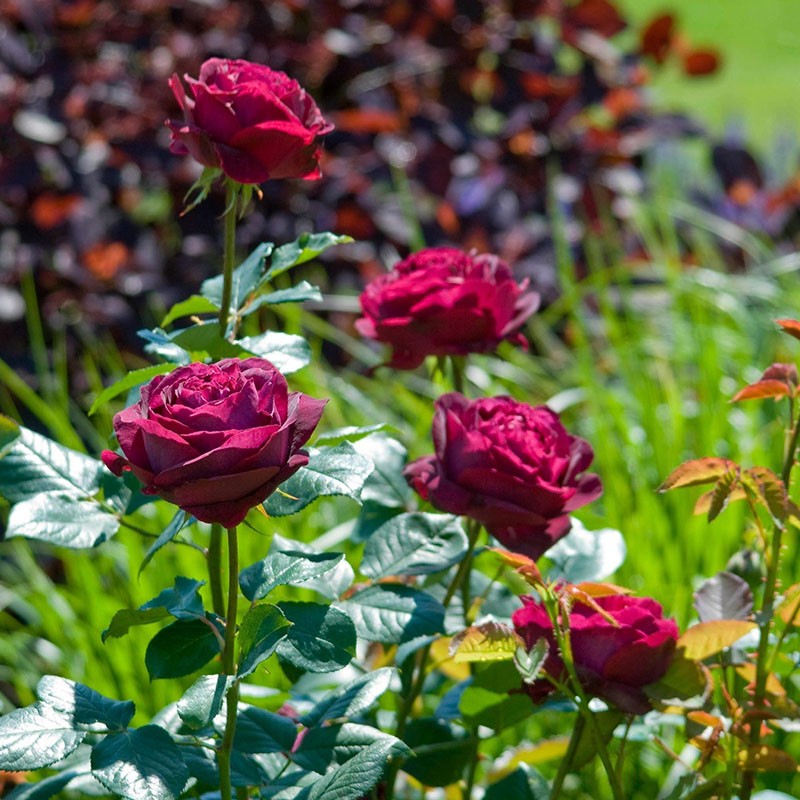How to grow an English rose Falstaff on your site
 Rose Falstaff is a popular ornamental plant species, bred by English breeders. This plant is widely used in landscaping and landscape design, as it successfully combines aesthetic appeal, luxurious, rich aroma and unpretentious care.
Rose Falstaff is a popular ornamental plant species, bred by English breeders. This plant is widely used in landscaping and landscape design, as it successfully combines aesthetic appeal, luxurious, rich aroma and unpretentious care.
Botanical description and characteristics


Main features of the Falstaff rose:
- The rose bush is branched, straight, powerful and vigorous. The diameter of the bush reaches 80-100 cm.
- The plant has a powerful and branched root system, which can extend into the soil by 1.5-2 m.
- Plant stems reach a height of 1-1.5 m. Shoots are highly branching and fast-growing.
- Leaves are medium in size, oval, oblong in shape, with a shiny, glossy surface, rich green color.
- The buds are cup-shaped, up to 10-12 cm in diameter, collected in clusters up to 6-8 pcs. One shoot has up to 40-45 flowers.
One of the main advantages of the Falstaff rose is its luxurious, profuse and long flowering. The shrub is covered with large flower buds with dense, velvety petals. Flowers attract attention with a rich dark crimson color with a slight purple tint.
Rose Falstaff: growing
 Due to its unpretentiousness and ease of planting and care, the English rose Falstaff is often used in landscape design, when decorating park areas, gardens and personal plots.
Due to its unpretentiousness and ease of planting and care, the English rose Falstaff is often used in landscape design, when decorating park areas, gardens and personal plots.
The Falstaff English park rose is best planted in spring, when the soil warms up to + 15 ° C. In order to get a beautiful flower bush, which will become a decoration of the garden, follow the basic rules of growing and caring for the plant.
Choosing healthy seedlings
 Particular attention should be paid to the choice of seedlings, because the success of planting work depends on this. British seedlings take root with ease and adapt very quickly to new soil and conditions.
Particular attention should be paid to the choice of seedlings, because the success of planting work depends on this. British seedlings take root with ease and adapt very quickly to new soil and conditions.
It is best to choose seedlings in specialized nurseries. Carefully inspect the vaccination site - there should be no stains, traces of rot and mold, cracks. Darkened or grayish parts on the stems and roots of the seedling indicate a low quality of the planting material.
Choosing a landing site
 For planting a Falstaff rose, shady areas are suitable, away from penetrating drafts. It is best to plant a plant near a house or other buildings. The site should not be low-lying, since the root system of the plant does not tolerate stagnant water.
For planting a Falstaff rose, shady areas are suitable, away from penetrating drafts. It is best to plant a plant near a house or other buildings. The site should not be low-lying, since the root system of the plant does not tolerate stagnant water.
Also, sunny places are not suitable for planting crops, since direct rays can burn delicate leaves. When planting a rose near a house or fence, you need to retreat at a distance of at least 50-70 cm.
Preparing the soil for planting
 Prepare the soil about 4 weeks before planting. It should be plowed, loosened, and clay and humus should be added if necessary. If the soil is very poor, additional fertilizing is required - organic fertilizers, superphosphate, bone meal.
Prepare the soil about 4 weeks before planting. It should be plowed, loosened, and clay and humus should be added if necessary. If the soil is very poor, additional fertilizing is required - organic fertilizers, superphosphate, bone meal.
If the soil is excessively loose, crumbly, it must be additionally “weighted” using a clay substrate, then compost or humus should be added.
Preparation of seedlings
 Seedlings must be properly prepared before planting. First of all, disinfect the bare roots by dipping for 30 minutes in a bucket of water with 30 g of Fundazole or copper sulfate. Examine the roots of the seedlings carefully, remove all dried fragments.
Seedlings must be properly prepared before planting. First of all, disinfect the bare roots by dipping for 30 minutes in a bucket of water with 30 g of Fundazole or copper sulfate. Examine the roots of the seedlings carefully, remove all dried fragments.
After that, soak the roots of the seedlings for a while in a growth stimulator - Ecosil or Kornevin solutions. Immediately before planting, treat the roots of the roses with a clay-manure mixture with Heteroauxin (1 tablet per bucket of water).
Rose planting procedure
 Falstaff roses have a spreading root system, so prepare holes for planting them at least 70 cm deep and wide.
Falstaff roses have a spreading root system, so prepare holes for planting them at least 70 cm deep and wide.
Landing technique:
- Loosen the bottom of the hole, then fill in a layer of drainage, on top - a layer of soil mixture up to 4-6 cm high.It can be clay powder, compost, a mixture of deciduous and sod soil.
- Dip the roots of the rose bush into the hole and spread well.
- Sprinkle the shoots with a fertile substrate on top and tamp it lightly.
- When planting grafted seedlings, make sure that the root point is 5 cm deep into the soil.

- After completing all the steps, water the rose bush abundantly, again lightly tamp and spud with soft, loose soil, creating a kind of roller up to 13-15 cm high.

If Falstaff roses are planted in the fall, be sure to mulch the trunk circle with hay or compost.  For group planting, leave a distance of at least 70-80 cm and about 90-100 cm between rows.
For group planting, leave a distance of at least 70-80 cm and about 90-100 cm between rows.
Plant care rules
Falstaff roses are easy and unpretentious in care. When growing them, the standard rules are followed - watering, loosening, weeding, spraying to fight diseases and pests.
Watering and the required humidity
 Falstaff roses love moisture. Make sure that the trunk circle does not dry out. The best option would be drip irrigation of rose bushes. It can be replaced with manual watering - in this case, pour at least 2 buckets of clean, settled water under each bush.
Falstaff roses love moisture. Make sure that the trunk circle does not dry out. The best option would be drip irrigation of rose bushes. It can be replaced with manual watering - in this case, pour at least 2 buckets of clean, settled water under each bush.
When watering, pour water only into special recesses made in the near-stem holes. Then, level the soil with a rake. Do not allow water to get on the leaves of the rose, especially in hot weather - this can lead to their burns and the death of young shoots.
Falstaff rose feeding
 The first feeding of Falstaff roses is required immediately after rooting. It is best to use humus, rotted manure or other organic fertilizers. At the same time, plowing of the soil is carried out - thanks to this, nutrients can penetrate deep into the roots of the plant.
The first feeding of Falstaff roses is required immediately after rooting. It is best to use humus, rotted manure or other organic fertilizers. At the same time, plowing of the soil is carried out - thanks to this, nutrients can penetrate deep into the roots of the plant.
Organics can be replaced with ready-made mineral fertilizers. They have a complex composition, which includes potassium, nitrogen, phosphorus and other trace elements necessary for roses. Such dressings are made according to the instructions for the preparation.
Plant pruning
 When growing Falstaff roses, do not forget to timely remove wilted inflorescences. For this purpose, cut 2 pairs of leaves below the flower bud. This promotes rapid re-budding.
When growing Falstaff roses, do not forget to timely remove wilted inflorescences. For this purpose, cut 2 pairs of leaves below the flower bud. This promotes rapid re-budding.
Diseases and pests
 The English rose Falstaff is resistant to fungal diseases, caterpillar, scale insect, aphids and other pests. For additional protection for preventive purposes, the strengthened bushes can be treated with insecticidal preparations - Bi-58 Novy, Aktara.
The English rose Falstaff is resistant to fungal diseases, caterpillar, scale insect, aphids and other pests. For additional protection for preventive purposes, the strengthened bushes can be treated with insecticidal preparations - Bi-58 Novy, Aktara.
Spraying is carried out in the evening, in dry and calm weather. If necessary, re-processing is carried out, but already in the summer, after the end of the first stage of rose flowering.
The English rose Falstaff is an ornamental plant that is distinguished by its magnificent appearance, lush and abundant flowering, strong immunity and unpretentious care.Observing simple rules, you can grow luxurious bushes, which will become a decoration of a garden or a personal plot for the whole summer.